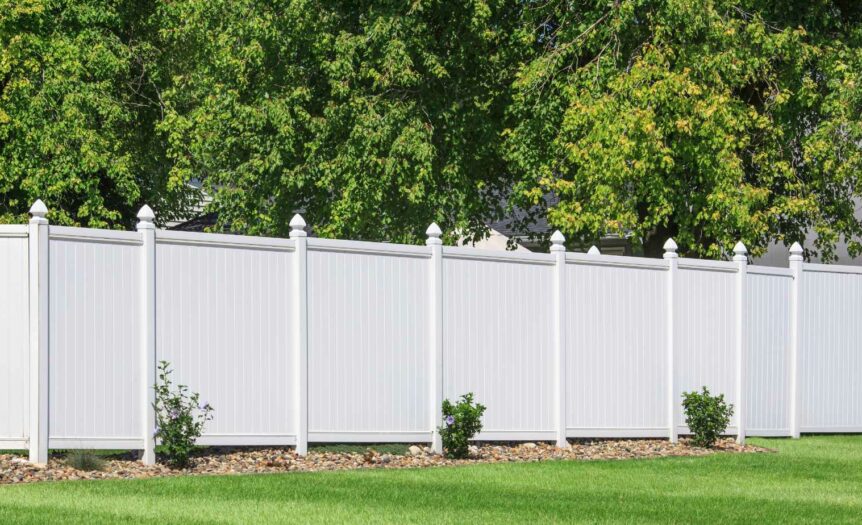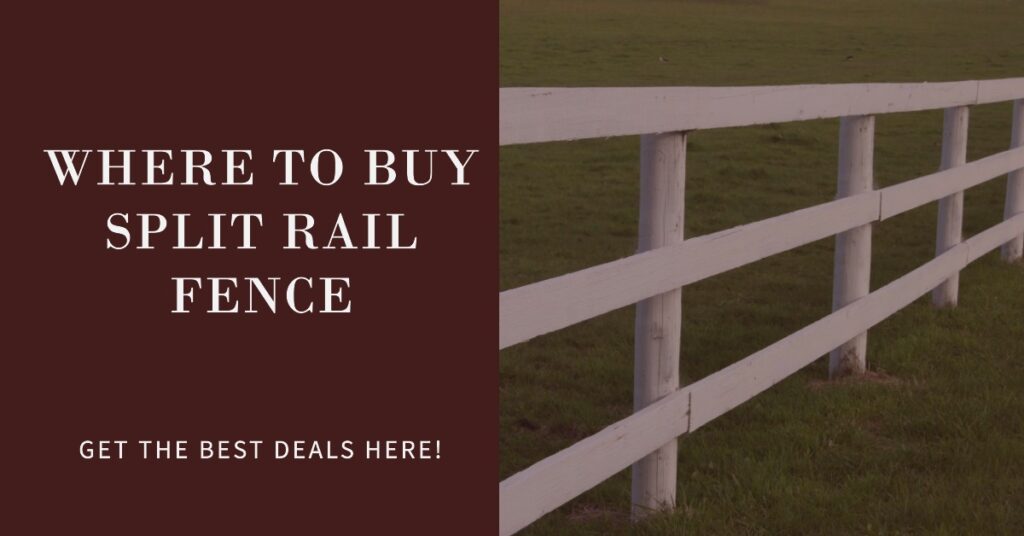Are you looking to enhance your property’s aesthetics with a timeless and cost-effective fencing option? Look no further than the classic split rail fence! This versatile and charming addition can create an attractive boundary for gardens, ranches, and various outdoor spaces.
In today’s blog post, we’ll explore the different types of materials available for split rail fences while also helping you find where to buy them – from local stores to online retailers.
Different Types And Materials For Split Rail Fences
Split rail fences come in various types and materials such as cedar wood, vinyl, and pressure-treated pine, each with its own unique characteristics to suit different styles and preferences.
Cedar Wood
Cedar wood is a popular choice for split rail fences due to its natural beauty, durability, and resistance to insect infestation. This type of wood has a distinct reddish-brown hue and exudes a pleasant aroma that adds an extra layer of charm to any outdoor setting.
In addition to its visual appeal, cedar wood requires minimal maintenance as it naturally repels insects and resists decay. This makes it ideal for homeowners who want an eco-friendly fencing option without having to invest in costly treatments or repairs over time.
Moreover, cedar ages gracefully with time; the patina it develops further enhances the rustic feel of your fence while still maintaining structural integrity.
Vinyl
Another popular option for split rail fencing is vinyl. Vinyl fencing materials offer several benefits, including durability and low maintenance requirements. Unlike wooden fences that may require frequent painting or staining, vinyl fences do not need any special coatings to maintain their appearance.
Additionally, since they are made of plastic, they are resistant to rotting and insect damage. One of the most significant advantages of using a vinyl fence is that it can withstand harsh weather conditions without cracking or warping like wood might over time.
Pressure Treated Pine
Pressure treated pine is another popular option for split rail fencing, offering durability and longevity. The process of pressure treating involves infusing the wood with chemicals to prevent rotting and insect damage.
This type of fencing material is a cost-effective alternative to cedar and can last up to 20 years with proper maintenance. Cashman’s Split Rail Fencing offers pressure-treated Southern Yellow Pine for those looking for long-lasting options that also fit their budget.
Benefits Of Split Rail Fences
Split rail fences offer several benefits, including enhancing outdoor aesthetics with their rustic and natural look, providing a cost-effective solution for fencing needs, and creating an ideal boundary marker for gardens or livestock.
Enhances Outdoor Aesthetics
One of the key benefits of a split rail fence is that it adds rustic charm and enhances the overall outdoor aesthetics of your property. These fences blend in perfectly with natural settings, whether you’re looking to create a traditional look for your country-style home or add some rural accents to your suburban yard.
Split rail fences provide an attractive boundary without obstructing views or overpowering the environment around them. The natural wood material complements greenery and landscaping well, adding depth and character to any outdoor setting.
Provides Natural Fencing
Split rail fences provide a natural and rustic look that enhances the outdoor aesthetics of any property. Unlike other fencing options, such as metal or vinyl, split rail fences blend seamlessly into their surroundings and complement the natural beauty of gardens and landscapes.
Split rail fences also create a natural boundary without completely shutting off the surrounding environment. This makes them an ideal choice for properties with stunning panoramic views, where traditional solid fencing would block out much of the scenery.
Cedar split rails are a popular material for building split rail fences because they are naturally resistant to decay and insects. They can last up to 20 years without being treated with chemicals or preservatives.
However, pressure-treated pine is another option that can be used in areas with high moisture content or termite problems for long-lasting durability.
Cost-effective Solution
One of the biggest advantages of split rail fencing is its affordability. Compared to other types of fences, such as chain-link or wrought iron, a split rail fence is relatively cheap to install and maintain over time.
For example, Lowe’s offers pre-cut wood rails for a split rail fence starting at just $8.25 per piece. The Split Rail Fence Store sells cedar wood rails in bulk starting at $1.29 per linear foot.
Of course, the final cost will vary depending on factors such as size and materials used, but overall a split rail fence is an affordable and cost-effective solution for those looking to add some rustic charm to their outdoor space without spending a fortune.
Where To Buy Split Rail Fence
The options for purchasing split rail fence include local stores such as Split Rail Fence Store, Home Depot, Lowe’s, and Tractor Supply Co., online retailers like Amazon and Wayfair, and even local fencing companies.
Local Stores: Split Rail Fence Store, Home Depot, Lowe’s, Tractor Supply Co.
If you prefer to see split rail fence options in-person, local stores can provide a variety of quality materials. The Split Rail Fence Store is a family-owned business that offers competitive pricing and excellent customer service.
Home Depot and Lowe’s also offer split rail fencing materials both online and in-store for convenient shopping options. Tractor Supply Co. is another store that provides Southern Yellow Pine pressure-treated wood for long-lasting fencing options.
Online Retailers: Amazon, Wayfair
For those who prefer the convenience of online shopping, Amazon and Wayfair are great options to buy split rail fence. These retailers offer a variety of materials and styles for customer selection.
On Amazon, customers can find cedar wood split rail fencing kits with easy installation instructions that can be shipped right to their doorstep.
It is important to note that before making a purchase, buyers should consider quality of materials, pricing affordability, customer service support, delivery options provided by the supplier.
Local Fencing Companies
In addition to retail stores and online retailers, there are also local fencing companies that offer split rail fence options. These companies often provide custom installations along with their products, ensuring that the fence fits the buyer’s specific needs.
Examples of these companies include Cashman’s Split Rail Fencing and Appalachian Fence Company. It is important to research local fencing companies in your area before making a purchase as they may offer unique materials or pricing options not found elsewhere.
Factors To Consider When Choosing A Split Rail Fence Supplier
When choosing a supplier for your split rail fence, consider factors such as the quality of materials provided, price and affordability, customer service and support options available from the supplier, and delivery or installation services offered.
Quality Of Materials
Choosing a reputable supplier with high-quality materials is crucial when buying split rail fence. Inferior materials will result in poor durability and aesthetic appeal, compromising the value of your investment.
For example, Split Rail Fence store offers high-grade cedar wood that has been hand-selected for its beauty and durability. Lowe’s also provides pressure-treated pine rails that resist rot and decay, ensuring long-lasting quality.
It’s essential to consider the type of wood used and how it was sourced since this can impact overall quality.
Price And Affordability
One of the primary concerns for most people when purchasing a split rail fence is the cost. The price of a split rail fence can vary depending on various factors like material, quality, and length.
Cedar wood fences tend to be more expensive than pressure-treated pine or vinyl fencing materials. However, cedar wood is more durable and resists rotting better than other wooden options.
It’s important to research and compare prices from different suppliers before making your purchase. For example, Lowe’s offers online purchasing options that make pricing comparison much easier.
Ensure that you keep in mind not only the upfront cost but also any additional expenses such as installation fees if necessary before deciding on your preferred supplier.
Customer Service And Support
When it comes to buying a split rail fence, customer service and support are important factors to consider. A reliable supplier will offer personalized guidance throughout the entire process, from choosing the right materials to installation and maintenance.
Some suppliers offer additional services such as free estimates or on-site consultations. For example, Cashman’s Split Rail Fencing provides consultation services that include property measurements and stake out placement using GPS technology.
Lowe’s also offers online resources such as how-to guides and instructional videos that can help you plan your fence project more efficiently.
Delivery And Installation Options
When it comes to buying and installing split rail fencing, delivery and installation options are important factors to consider. Many local stores that sell split rail fence materials offer delivery services for an additional fee, which can save time and effort for those who don’t have access to a large vehicle or trailer.
Some retailers also offer installation services, which can make the process easier and more efficient.
However, some buyers opt for DIY installations to save on costs. In this case, it’s crucial to ensure that the supplier provides clear instructions and guidance for proper installation.
Regardless of whether you choose professional installation or a DIY approach, it’s essential to factor in these options when considering where to buy your split rail fence materials.
Tips For Installing A Split Rail Fence
Installing a split rail fence can be an easy and fun DIY project, but it’s important to follow these tips to ensure a successful installation. Learn how to determine property lines, prepare the site, install posts and rails, and more by checking out our helpful guide.
Determine Property Lines
Knowing your property lines is crucial when installing a split rail fence to avoid encroaching on your neighbor’s land or violating local ordinances. To determine property lines, it’s best to consult with a licensed surveyor who can use GPS technology and other tools to accurately locate the boundaries.
However, if you’re on a budget, you can also check your deed for boundary descriptions or look for landmarks such as trees, fences, or markers placed by previous owners. It’s important to note that even if an existing fence appears to be at the boundary line, it may not reflect the actual legal boundary of your property.
Prepare The Site
Before starting the installation of a split rail fence, it’s important to prepare the site properly. This involves determining where the fence will be installed and clearing any obstacles from that area.
It’s also necessary to dig post holes for corner and end posts, ensuring they are in line with each other and level.
It’s best practice to mark out the areas where rails will be placed by measuring between the corner posts and marking at intervals along this distance with stakes or spray paint.
Afterward, set intermediates posts evenly spaced between these points before hanging your split rails for a sturdy fence construction.
Install The Corner And End Posts First
When installing a split rail fence, it is important to start by installing the corner and end posts. These posts will provide the framework for your fence and ensure that it is stable and secure.
Once you have determined where your corner and end posts will go, mark their location using stakes or spray paint. Then dig the postholes at least 2 feet deep to ensure they can withstand wind and other outside elements.
When selecting materials for your split rail fence, consider options like pressure-treated pine from Cashman’s Split Rail Fencing or rustic cedar wood from online retailers like Amazon or Wayfair.
Always measure carefully when cutting rails, as even small discrepancies can result in an uneven-looking fence line.
Measure And Mark Where The Rails Will Be Placed
One important step when installing a split rail fence is to measure and mark where the rails will be placed. This helps ensure that the fence looks straight, level, and symmetrical.
It’s also essential to make sure that the posts are evenly spaced apart, as this determines how many rails will be needed for the fence. For example, if there were six posts spaced ten feet apart, five rails would typically be needed to cover the span between them.
Secure The Rails To The Posts
To secure the rails to the posts in a split rail fence installation, it is important to use sturdy hardware such as galvanized nails and screws. Typically, two or three nails or screws are used per rail on both sides of each post.
This ensures that the rails sit securely and don’t shift with exposure to strong winds or pressure from animals. It’s also important to ensure that each rail is level before securing it to the post, using a spirit level if necessary.
Using high-quality materials for your fencing project is crucial when considering this step in building your split rail fence. Choosing a reputable supplier such as Split Rail Fence Store, Home Depot or Tractor Supply Co will provide you with top-quality materials that adhere to industry-standard safety measures without breaking your budget.
Conclusion
In conclusion, split rail fences are a great addition to any outdoor space. With its natural look and cost-effective benefits, it’s no wonder why this type of fencing is preferred by many homeowners.
There are several options when it comes to purchasing split rail fencing materials, including local stores like Split Rail Fence Store and Tractor Supply Co., as well as online retailers such as Amazon and Wayfair.
When choosing a supplier, consider the quality of materials, price, customer service, and delivery options.







